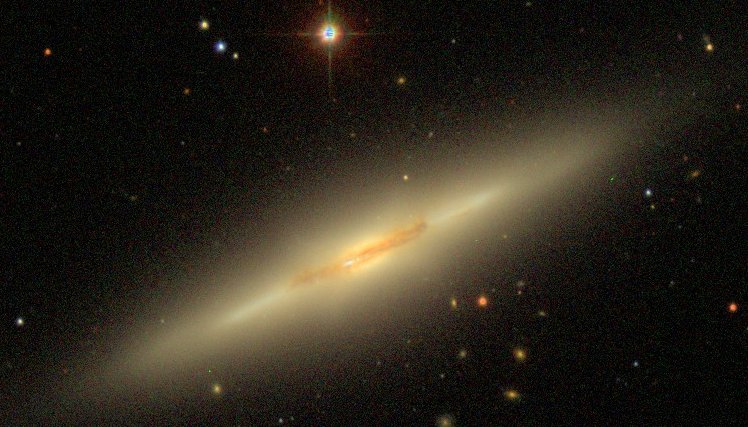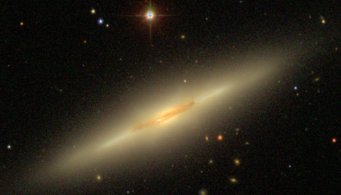Extragalactic Disks
Unveiling the vertical structure of disk galaxies with MUSE: properties and origin of the thin and thick disks
![Stellar population maps of NGC 3501. These maps shows the light-weighted age (top), metallicity [M/H] (mid) and [Mg/Fe]-abundance (bottom). The two MUSE pointings are indicated by gray lines and discarded bins are also displayed in gray. Black lines indicate different levels of surface brightness.The figure is adapted from Sattler et al. 2023](/5836337/original-1678098196.jpg?t=eyJ3aWR0aCI6OTY2LCJvYmpfaWQiOjU4MzYzMzd9--e7cc0c4a35de86e61c67d3a97487824566d724bb)
The figure is adapted from Sattler et al. 2023
We extract stellar-kinematic and population maps of the edge-on spiral galaxy NGC 3501, using deep integral-field spectroscopy observations covering the right half of the edge-on galaxy with two MUSE pointings. While this galaxy was previously fitted with only one disk component (Comerón et al., 2018), our stellar-population maps uncover a younger metal-rich thin disk in the inner region of the midplane, embedded in a slightly older and metal-poor thicker disk. Comparing the star formation history of the inner thin metal-rich disk and the thick metal-poor disk, we aim at a better understanding of the evolutionary connection between thin and thick disks and the mass assembly of disk galaxies. Our results suggest this spiral galaxy is being observed in an early evolutionary phase, with a thick disk already in place and an inner thin disk in the first stages of its formation. We are probably witnessing the birth of a future massive thin disk, growing inside-out, embedded in a preexisting thick disk.
Data: MUSE/VLT
For more details, please contact Natascha Sattler.

The S0 galaxy NGC 4710, seen edge on, has two distinct disk components: a thick and a thin disk. In this project, we extract stellar-kinematic maps from a mosaic of two MUSE/VLT pointings and assess the differences between the thin and the thick disks (e.g., the thick-disk rotation lag). We compare our results with theoretical models and discuss them in the context of thick-disk formation and galaxy evolution.
Data: MUSE/VLT
For more details, please contact Celine Greis.
The shape of the stellar velocity ellipsoid (SVE) in galactic disks, i.e. the balance between the vertical and radial velocity dispersions, keeps the record of the past disk dynamical heating. We constrain the disk SVEs of a sample of eight galaxies in the Fornax cluster, applying orbit-superposition methods, based on Schwarzschild dynamical models, to deep MUSE integral-field spectroscopy data from the Fornax 3D Survey. We study the SVE shape as function of the galaxy morphological type and we discuss the results in the context of the Fornax galaxy cluster. For six galaxies, we will be able to associate different SVE shape with different ages, reconstructing the evolution of the SVE, and different metallicities .
Data: MUSE/VLT
For more information, please contact Francesca Pinna.
This project focuses on the measurement of disk thickness and its increase with galactocentric radius (flaring) for different mono-age populations. We extract maps for mono-age stellar populations, from the results published in Pinna et al. (2019a) and Pinna et al. (2019b), for three edge-on lenticular galaxies in the Fornax 3D Survey. We fit vertical density profiles from these maps with the goal of analysing the scale height as a function of stellar age. We aim at testing whether different mono-age populations flare at different radii as it was shown, e.g., for the Milky Way. This allows us to track the time evolution of thickness and uncover trends of the flaring shape with stellar age.
Data: MUSE/VLT
For more details, contact Francesca Pinna, pinna@mpia.de
For a numerical analysis of thin and thick disks in the AURIGA zoom-in simulations, see the project page on simulations.
![Stellar population maps of NGC 3501. These maps shows the light-weighted age (top), metallicity [M/H] (mid) and [Mg/Fe]-abundance (bottom). The two MUSE pointings are indicated by gray lines and discarded bins are also displayed in gray. Black lines indicate different levels of surface brightness.The figure is adapted from Sattler et al. 2023 Stellar population maps of NGC 3501. These maps shows the light-weighted age (top), metallicity [M/H] (mid) and [Mg/Fe]-abundance (bottom). The two MUSE pointings are indicated by gray lines and discarded bins are also displayed in gray. Black lines indicate different levels of surface brightness.The figure is adapted from Sattler et al. 2023](/5836337/original-1678098196.jpg?t=eyJ3aWR0aCI6MzQxLCJmaWxlX2V4dGVuc2lvbiI6ImpwZyIsIm9ial9pZCI6NTgzNjMzN30%3D--127f7e8f6240f4bc0569cb1d80aee1a2a7bc5969)
